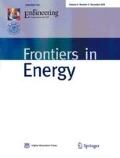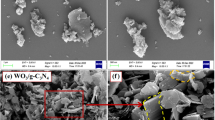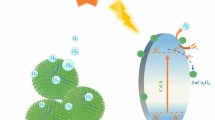Abstract
Photocatalytic water splitting for hydrogen (H2) generation is a potential strategy to solve the problem of energy crisis and environmental deterioration. However, powder-like photocatalysts are difficult to recycle, and the agglomeration of particles would affect the photocatalytic activity. Herein, a direct Z-scheme CdS/WO3 composite photocatalyst was fabricated based on carbon cloth through a two-step process. With the support of carbon cloth, photocatalysts tend to grow uniformly for further applications. The experimental results showed that the H2 yield of adding one piece of CdS/WO3 composite material was 17.28 μmol/h, which was 5.5 times as compared to that of pure CdS-loaded carbon cloth material. A cycle experiment was conducted to verify the stability of the as-prepared material and the result demonstrated that the H2 generation performance of CdS/WO3 decreased slightly after 3 cycles. This work provides new ideas for the development of recyclable photocatalysts and has a positive significance for practical applications.
Similar content being viewed by others
References
Hayat A, Chen Z, Luo Z, et al. Π-deficient pyridine ring-incorporated carbon nitride polymers for photocatalytic H2 evolution and CO2 fixation. Research on Chemical Intermediates, 2021, 47(1): 15–27
Xu J, Mao M, Yu H. Functionalization of sheet structure Co-Mo-S with Ni(OH)2 for efficient photocatalytic hydrogen evolution. Research on Chemical Intermediates, 2020, 46(3): 1823–1840
Turner J A. Sustainable hydrogen production. Science, 2004, 305 (5686): 972–974
Fujishima A, Honda K. Electrochemical photolysis of water at a semiconductor electrode. Nature, 1972, 238(5358): 37–38
Tang J, Gao B, Pan J, et al. CdS nanorods anchored with CoS2 nanoparticles for enhanced photocatalytic hydrogen production. Applied Catalysis A: General, 2019, 588: 117281
Kumaravel V, Mathew S, Bartlett J, et al. Photocatalytic hydrogen production using metal doped TiO2: a review of recent advances. Applied Catalysis B: Environmental, 2019, 244: 1021–1064
Sampaio M J, Oliveira J W L, Sombrio C I L, et al. Photocatalytic performance of Au/ZnO nanocatalysts for hydrogen production from ethanol. Applied Catalysis A: General, 2016, 518: 198–205
Zhu C, Liu C, Fu Y, et al. Construction of CDs/CdS photocatalysts for stable and efficient hydrogen production in water and seawater. Applied Catalysis B: Environmental, 2019, 242: 178–185
Shang L, Tong B, Yu H, et al. CdS nanoparticle-decorated Cd nanosheets for efficient visible light-driven photocatalytic hydrogen evolution. Advanced Energy Materials, 2016, 6(3): 1501241
Hao X, Wang Y, Zhou J, et al. Zinc vacancy-promoted photocatalytic activity and photostability of ZnS for efficient visible-light-driven hydrogen evolution. Applied Catalysis B: Environmental, 2018, 221: 302–311
Zhao J, Zhang Z, Chen X, et al. Microwave-induced assembly of CuS@MoS2 core-shell nanotubes and study on their photocatalytic Fenton-like reactions. Acta Chimica Sinica, 2020, 78(9): 961–967
Prasad C, Tang H, Liu Q, et al. A latest overview on photocatalytic application of g-C3N4 based nanostructured materials for hydrogen production. International Journal of Hydrogen Energy, 2020, 45(1): 337–379
Kim D, Yong K. Boron doping induced charge transfer switching of aC3N4/ZnO photocatalyst from Z-scheme to type II to enhance photocatalytic hydrogen production. Applied Catalysis B: Environmental, 2021, 282: 119538
Yuan Y J, Chen D, Yu Z T, et al. Cadmium sulfide-based nanomaterials for photocatalytic hydrogen production. Journal of Materials Chemistry A, 2018, 6(25): 11606–11630
Wei R, Huang Z, Gu G, et al. Dual-cocatalysts decorated rimous CdS spheres advancing highly-efficient visible-light photocatalytic hydrogen production. Applied Catalysis B: Environmental, 2018, 231: 101–107
Wang D, Zeng H, Xiong X, et al. Highly efficient charge transfer in CdS-covalent organic framework nanocomposites for stable photocatalytic hydrogen evolution under visible light. Science Bulletin, 2020, 65(2): 113–122
Villa K, Murcia-López S, Andreu T, et al. Mesoporous WO3 photocatalyst for the partial oxidation of methane to methanol using electron scavengers. Applied Catalysis B: Environmental, 2015, 163: 150–155
Jin J, Yu J, Guo D, et al. A hierarchical Z-scheme CdS-WO3 photocatalyst with enhanced CO2 reduction activity. Small, 2015, 11 (39): 5262–5271
Maeda K. Z-scheme water splitting using two different semiconductor photocatalysts. ACS Catalysis, 2013, 3(7): 1486–1503
Xu Q, Zhang L, Yu J, et al. Direct Z-scheme photocatalysts: principles, synthesis, and applications. Materials Today, 2018, 21 (10): 1042–1063
Niu X, Bai X, Zhou Z, et al. Rational design and characterization of direct Z-scheme photocatalyst for overall water splitting from excited state dynamics simulations. ACS Catalysis, 2020, 10(3): 1976–1983
Liu Q, Shen J, Yang X, et al. 3D reduced graphene oxide aerogel-mediated Z-scheme photocatalytic system for highly efficient solar-driven water oxidation and removal of antibiotics. Applied Catalysis B: Environmental, 2018, 232: 562–573
Zhou F, Fan J, Xu Q, et al. BiVO4 nanowires decorated with CdS nanoparticles as Z-scheme photocatalyst with enhanced H2 generation. Applied Catalysis B: Environmental, 2017, 201: 77–83
Wang S, Zhu B, Liu M, et al. Direct Z-scheme ZnO/CdS hierarchical photocatalyst for enhanced photocatalytic H2-production activity. Applied Catalysis B: Environmental, 2019, 243: 19–26
Qiu B, Zhu Q, Du M, et al. Efficient solar light harvesting CdS/Co9S8 hollow cubes for Z-scheme photocatalytic water splitting. Angewandte Chemie International Edition, 2017, 56(10): 2684–2688
Cui H, Li B, Li Z, et al. Z-scheme based CdS/CdWO4 heterojunction visible light photocatalyst for dye degradation and hydrogen evolution. Applied Surface Science, 2018, 455: 831–840
Balta Z, Bilgin Simsek E, Berek D. Solvothermal synthesis of WO3/TiO2/carbon fiber composite photocatalysts for enhanced performance under sunlight illumination. Photochemistry and Photobiology, 2019, 95(6): 1331–1338
Li F, Chen L, Knowles G P, et al. Hierarchical mesoporous SnO2 nanosheets on carbon cloth: a robust and flexible electrocatalyst for CO2 reduction with high efficiency and selectivity. Angewandte Chemie International Edition, 2017, 56(2): 505–509
Vaiano V, Iervolino G. Facile method to immobilize ZnO particles on glass spheres for the photocatalytic treatment of tannery wastewater. Journal of Colloid and Interface Science, 2018, 518: 192–199
Huang Y, Guo Z, Liu H, et al. Heterojunction architecture of N-doped WO3 nanobundles with Ce2S3 nanodots hybridized on a carbon textile enables a highly efficient flexible photocatalyst. Advanced Functional Materials, 2019, 29(45): 1903490
Wang J, Khoo E, Lee P S, et al. Synthesis, assembly, and electrochromic properties of uniform crystalline WO3 nanorods. Journal of Physical Chemistry C, 2008, 112(37): 14306–14312
Kim C H, Kim B H, Yang K S. TiO2 nanoparticles loaded on graphene/carbon composite nanofibers by electrospinning for increased photocatalysis. Carbon, 2012, 50(7): 2472–2481
Shi J, Cui H, Chen J, et al. TiO2/activated carbon fibers photocatalyst: Effects of coating procedures on the microstructure, adhesion property, and photocatalytic ability. Journal of Colloid and Interface Science, 2012, 388(1): 201–208
Peng Q, Li Y, He X, et al. Interfacial enhancement of carbon fiber composites by poly(amido amine) functionalization. Composites Science and Technology, 2013, 74: 37–42
Gu L, Wang J, Cheng H, et al. One-step preparation of graphene-supported anatase TiO2 with exposed {001} facets and mechanism of enhanced photocatalytic properties. ACS Applied Materials & Interfaces, 2013, 5(8): 3085–3093
Hu T, Li P, Zhang J, et al. Highly efficient direct Z-scheme WO3/CdS-diethylenetriamine photocatalyst and its enhanced photocatalytic H2 evolution under visible light irradiation. Applied Surface Science, 2018, 442: 20–29
Zhang L J, Li S, Liu B K, et al. Highly efficient CdS/WO3 photocatalysts: Z-scheme photocatalytic mechanism for their enhanced photocatalytic H2 evolution under visible light. ACS Catalysis, 2014, 4(10): 3724–3729
Acknowledgements
This work was supported by the National Natural Science Foundation of China (Grant No. 21972040), the Program of Introducing Talents of Discipline to Universities (B20031), the Innovation Program of Shanghai Municipal Education Commission (2021-01-07-00-02-E00106), the Science and Technology Commission of Shanghai Municipality (20DZ2250400), and Fundamental Research Funds for the Central Universities.
Author information
Authors and Affiliations
Corresponding author
Electronic Supplementary Material
Rights and permissions
About this article
Cite this article
Xu, Z., Zhu, Q., Xi, X. et al. Z-scheme CdS/WO3 on a carbon cloth enabling effective hydrogen evolution. Front. Energy 15, 678–686 (2021). https://doi.org/10.1007/s11708-021-0768-6
Received:
Accepted:
Published:
Issue Date:
DOI: https://doi.org/10.1007/s11708-021-0768-6




